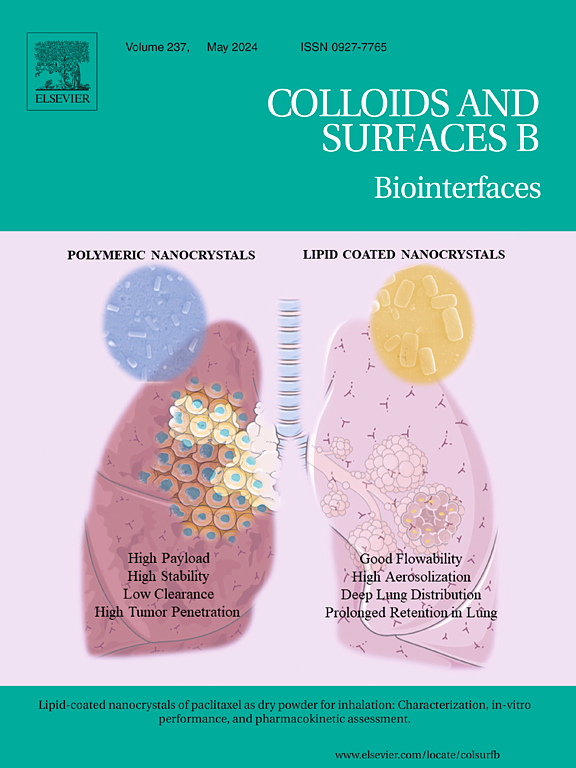pH-responsive chitosan-sodium alginate nanocarriers for curcumin delivery against brain cancer
IF 5.4
2区 医学
Q1 BIOPHYSICS
引用次数: 0
Abstract
Curcumin (CUR) exhibits potent anticancer properties and has been widely investigated for the treatment of various malignancies. However, its clinical application is limited by poor aqueous solubility, rapid systemic metabolism, and a short circulation half-life. In the present study, a pH-responsive hybrid nanocarrier system was developed based on sodium alginate (SA), chitosan (CS), and cerium oxide (CeO₂) nanoparticles (NPs), using a water-in-oil-in-water (W/O/W) double emulsion technique. This system was designed to enhance CUR stability, enable controlled and sustained release, and improve pharmacokinetic parameters such as half-life and biodistribution. The resulting nanocarriers exhibited spherical morphology with textured surfaces, a positive surface charge, and nanoscale dimensions. Structural characterization via XRD and FTIR confirmed a quasi-amorphous composite matrix and successful encapsulation of CUR, achieving an encapsulation efficiency of approximately 86 %. Drug release studies conducted at physiological and acidic pH demonstrated a sustained, pH-dependent release profile, well-fitted by the Baker–Lonsdale kinetic model. Cytotoxicity assays using U-87MG2 glioma and healthy astrocyte cell lines indicated that the CUR-loaded nanocarriers selectively induced tumor cell death while exhibiting minimal toxicity toward normal cells. Moreover, the inclusion of CeO₂ NPs was found to mitigate CUR degradation under physiological conditions, thereby contributing to its enhanced therapeutic performance. Flow cytometry analysis further revealed a significant induction of apoptosis in glioma cells treated with the CUR-loaded nanocomposites. Collectively, these findings underscore the potential of the developed CS/SA/CeO₂@CUR nanoplatform as an effective and biocompatible strategy for brain cancer therapy.
ph响应壳聚糖-海藻酸钠纳米载体姜黄素递送抗脑癌
姜黄素(Curcumin, CUR)具有强大的抗癌特性,已被广泛研究用于治疗各种恶性肿瘤。但其水溶性差、全身代谢快、循环半衰期短,限制了其临床应用。以海藻酸钠(SA)、壳聚糖(CS)和氧化铈(ceo2)纳米颗粒(NPs)为基材,采用水包油/水包油(W/O/W)双乳液技术,制备了ph响应型混合纳米载体体系。该系统旨在提高CUR的稳定性,实现控制和缓释,并改善半衰期和生物分布等药代动力学参数。所得到的纳米载体呈现出具有纹理表面的球形形貌、表面带正电荷和纳米级尺寸。通过XRD和FTIR的结构表征证实了准非晶复合基体和成功封装CUR,封装效率约为86% %。在生理和酸性pH下进行的药物释放研究表明,持续的、依赖于pH的释放谱,与Baker-Lonsdale动力学模型很好地吻合。使用U-87MG2胶质瘤和健康星形胶质细胞细胞系进行的细胞毒性试验表明,负载cur的纳米载体选择性地诱导肿瘤细胞死亡,同时对正常细胞表现出最小的毒性。此外,研究发现,在生理条件下,包含CeO₂NPs可以减轻CUR的降解,从而提高其治疗性能。流式细胞术分析进一步显示,负载cur的纳米复合材料对胶质瘤细胞的凋亡有显著的诱导作用。总的来说,这些发现强调了开发的CS/SA/CeO₂@CUR纳米平台作为脑癌治疗的有效和生物相容性策略的潜力。
本文章由计算机程序翻译,如有差异,请以英文原文为准。
求助全文
约1分钟内获得全文
求助全文
来源期刊

Colloids and Surfaces B: Biointerfaces
生物-材料科学:生物材料
CiteScore
11.10
自引率
3.40%
发文量
730
审稿时长
42 days
期刊介绍:
Colloids and Surfaces B: Biointerfaces is an international journal devoted to fundamental and applied research on colloid and interfacial phenomena in relation to systems of biological origin, having particular relevance to the medical, pharmaceutical, biotechnological, food and cosmetic fields.
Submissions that: (1) deal solely with biological phenomena and do not describe the physico-chemical or colloid-chemical background and/or mechanism of the phenomena, and (2) deal solely with colloid/interfacial phenomena and do not have appropriate biological content or relevance, are outside the scope of the journal and will not be considered for publication.
The journal publishes regular research papers, reviews, short communications and invited perspective articles, called BioInterface Perspectives. The BioInterface Perspective provide researchers the opportunity to review their own work, as well as provide insight into the work of others that inspired and influenced the author. Regular articles should have a maximum total length of 6,000 words. In addition, a (combined) maximum of 8 normal-sized figures and/or tables is allowed (so for instance 3 tables and 5 figures). For multiple-panel figures each set of two panels equates to one figure. Short communications should not exceed half of the above. It is required to give on the article cover page a short statistical summary of the article listing the total number of words and tables/figures.
 求助内容:
求助内容: 应助结果提醒方式:
应助结果提醒方式:


